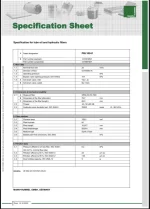They also reference the PLB30001 for the Boss. Nowhere does Purolator say it represents the overall efficiency average of the entire filter line.
Yes, they got you and 99.999% of the filter buyers with their advertising efficiency claim.

But now you know the game they play, lol. And other companies have done the same. As said before, Fram is probably the most transparent by using the avg efficiency of 3 different sized filters to represent the efficiency of the whole line.
WIX use use to show a beta ratio (another way to express efficiency) for basically every model, but not so much any more. No company is going to spend the time and money to physically ISO test every oil filter they make. If they ISO tested some filters across the size range they would know how the size (media area) effects the efficiency and model it. Or like Fram, the 3 sizes they choose to test probably covers the whole filter line (ie, PH, TG, XG, FE) for the avg efficiency pretty well. We saw with the Ascent testing that Fram isn't misleading, at least on the efficiency of the OG Ultra, and I'd suspect they are shooting straight on all their efficiency claims.



